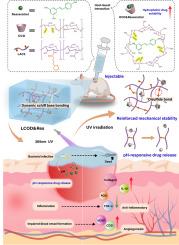Mechanically adaptive injectable hydrogels with dual-role oxidized cyclodextrin for pH-responsive drug delivery in chronic infected wound healing
IF 12.5
1区 化学
Q1 CHEMISTRY, APPLIED
引用次数: 0
Abstract
The management of chronically infected wounds remains challenging due to persistent bacterial colonization and unresolved inflammation. To address this, an injectable double-network hydrogel was developed to facilitate wound healing. Formation of the hydrogel occurred via a reversible Schiff base reaction between oxidized β-cyclodextrin (OCD) and α-lipoic acid–modified chitosan (LACS), imparting high injectability for thorough coverage of irregular wound sites. Notably, OCD played a dual role: encapsulating hydrophobic resveratrol via its hydrophobic inner cavity for pH-responsive release triggered by Schiff base bond cleavage, while also serving as a crosslinker by providing aldehyde groups for primary network formation. Upon UV exposure, a secondary disulfide bond network formed, enhancing mechanical stability and adaptability post-injection. The mechanical properties were tunable by adjusting OCD content to modulate Schiff base network density. In vitro, LCOD exhibited strong antibacterial, antioxidant, and biocompatible properties. In vivo results in a murine infected wound model showed that resveratrol-loaded LCOD promoted healing by reducing inflammation, enhancing collagen deposition, stimulating angiogenesis, and accelerating re-epithelialization. The multifunctional hydrogel combines ease of injection, tunable mechanical properties, and pH-triggered drug release, representing a promising therapeutic approach for managing chronic wounds.

具有双作用氧化环糊精的机械适应性注射水凝胶用于ph响应性药物递送慢性感染伤口愈合
由于持续的细菌定植和未解决的炎症,慢性感染伤口的管理仍然具有挑战性。为了解决这个问题,一种可注射的双网状水凝胶被开发出来,以促进伤口愈合。氧化的β-环糊精(OCD)和α-硫辛酸修饰的壳聚糖(LACS)通过可逆的希夫碱反应形成水凝胶,具有高注射性,可以完全覆盖不规则的伤口部位。值得注意的是,OCD发挥了双重作用:通过其疏水内腔封装疏水白藜芦醇,通过席夫碱键裂解触发ph响应释放,同时通过提供醛基形成初级网络作为交联剂。在紫外线照射下,形成二级二硫键网络,增强注入后的机械稳定性和适应性。通过调节OCD含量来调节希夫基网络密度,可调节材料的力学性能。在体外,LCOD表现出较强的抗菌、抗氧化和生物相容性。小鼠感染伤口模型的体内实验结果显示,白藜芦醇负载的LCOD通过减少炎症、增强胶原沉积、刺激血管生成和加速再上皮化来促进愈合。多功能水凝胶结合了易于注射,可调节的机械性能和ph触发的药物释放,代表了治疗慢性伤口的有前途的治疗方法。
本文章由计算机程序翻译,如有差异,请以英文原文为准。
求助全文
约1分钟内获得全文
求助全文
来源期刊

Carbohydrate Polymers
化学-高分子科学
CiteScore
22.40
自引率
8.00%
发文量
1286
审稿时长
47 days
期刊介绍:
Carbohydrate Polymers stands as a prominent journal in the glycoscience field, dedicated to exploring and harnessing the potential of polysaccharides with applications spanning bioenergy, bioplastics, biomaterials, biorefining, chemistry, drug delivery, food, health, nanotechnology, packaging, paper, pharmaceuticals, medicine, oil recovery, textiles, tissue engineering, wood, and various aspects of glycoscience.
The journal emphasizes the central role of well-characterized carbohydrate polymers, highlighting their significance as the primary focus rather than a peripheral topic. Each paper must prominently feature at least one named carbohydrate polymer, evident in both citation and title, with a commitment to innovative research that advances scientific knowledge.
 求助内容:
求助内容: 应助结果提醒方式:
应助结果提醒方式:


